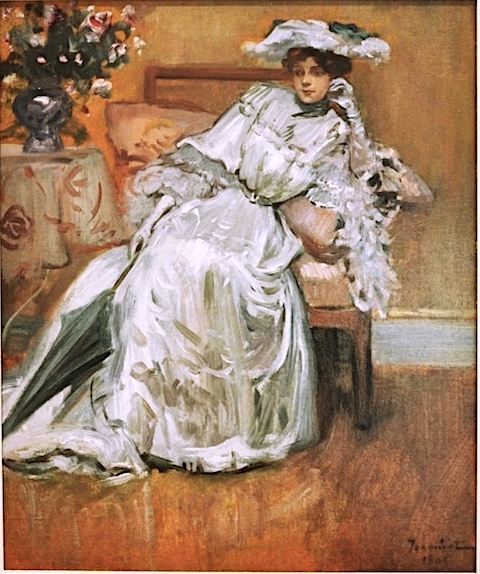Lionel-Noël Royer (1852-1926), according to his English language Wikipedia
entry, is best known for his large paintings of the life of Joan of Arc located in the Basilica of Bois-Chenu in Domrémy, her home town. His French Wikipedia
entry also notes that he is known "
ainsi que du tableau Vercingétorix jette ses armes aux pieds de Jules César." The latter ("Vercingétorix Throwing his Weapons at the Feet of Caesar" - 1899) is probably better known outside France because it has been used as book cover art. It's the image at the top of this post (click on it to enlarge).
Royer fought in one Franco-Prussian War battle, so was qualified to paint battle scenes even though he followed convention and overly dramatized the action. Following the war he studied art at
l'École des beaux-arts de Paris under Alexandre Cabanel and William Bouguereau.
Royer painted simple subjects, but excelled in dealing with complex scenes with casts worthy of a Cecil B. DeMille Biblical movie. Well, fewer people than in film crowd scenes, but plenty on artists' canvases.
Below are more examples of his work. But I have to say that I like the Julis Caesar painting best, even though the French link above states "
Les historiens soulignent notamment le fait que Vercingétorix ne s'est certainement pas présenté en armes devant César au moment de sa reddition (il aurait été massacré par la garde romaine). Le cheval est à l'époque une monture romaine, les Gaulois utilisant plutôt des poneys (plus petits). Le tableau traduit surtout une volonté d'héroïser le personnage de Vercingétorix." That is, what Royer painted probably did not actually happen the way he depicted the surrender.
Gallery
Joan of Arc at the coronation of Charles VII at Reims
Click on the image to enlarge.
Bataille d'Auvour
Also known as the Battle of Mans, fought 10-12 January 1871. A large but rag-tag French army was defeated by the Prussians. This battle, along with the end of the Siege of Paris a few days later, marked the end of the main military phase of the Franco-Prussian War
Le Lieutenant-Colonel Athanase de Charrette à la tête des Zouaves Pontificaux – Bataille de Mentana - 3 Novembre, 1867
This battle was between Garibaldi's Italians and an army comprised of the French and Papal Zouave troops. The Italians were defeated.
Marchande de Fleurs - The Flower Seller
The flower seller is at the lower right corner with her push-cart. At the lower left is a red automobile that dates the painting as from a few years around 1905. The large building is the Hôtel de Ville, Paris' city hall, and the tall structure at the right is the Notre-Dame.
The Muses Garden
The opposite of Royer's war paintings.
Allegory of Summer
Confirmation that he studied under Bouguereau.
Étude pour la figure de l'amour




















































